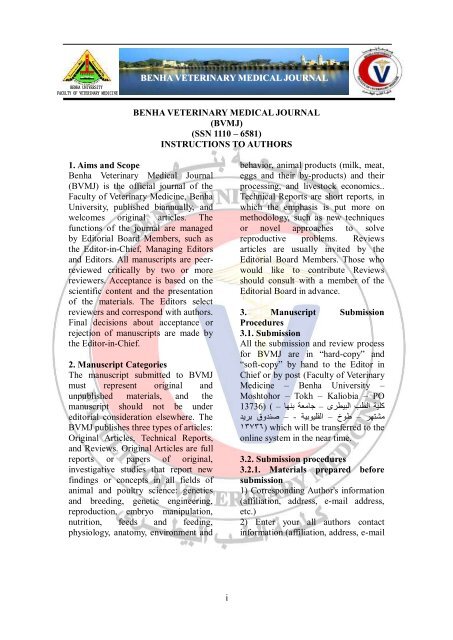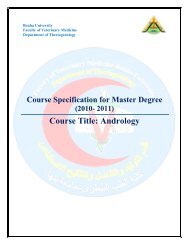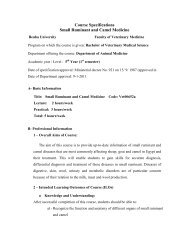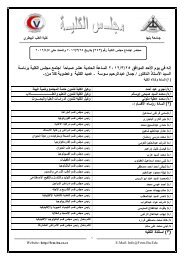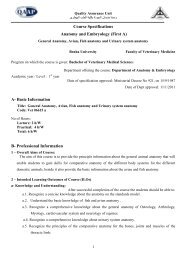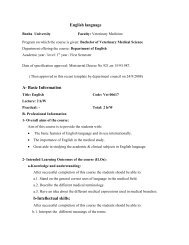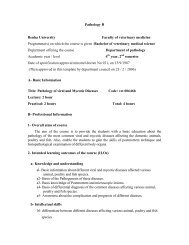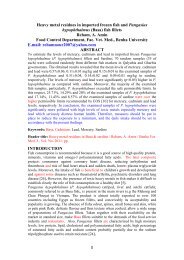BENHA VETERINARY MEDICAL JOURNAL BENHA VETERINARY ...
BENHA VETERINARY MEDICAL JOURNAL BENHA VETERINARY ...
BENHA VETERINARY MEDICAL JOURNAL BENHA VETERINARY ...
You also want an ePaper? Increase the reach of your titles
YUMPU automatically turns print PDFs into web optimized ePapers that Google loves.
<strong>BENHA</strong> UNIVERSITY<br />
FACULTY OF <strong>VETERINARY</strong> MEDICINE<br />
<strong>BENHA</strong> <strong>VETERINARY</strong> <strong>MEDICAL</strong> <strong>JOURNAL</strong><br />
<strong>BENHA</strong> <strong>VETERINARY</strong> <strong>MEDICAL</strong> <strong>JOURNAL</strong><br />
(BVMJ)<br />
(SSN 1110 – 6581)<br />
INSTRUCTIONS TO AUTHORS<br />
1. Aims and Scope<br />
Benha Veterinary Medical Journal<br />
(BVMJ) is the official journal of the<br />
Faculty of Veterinary Medicine, Benha<br />
University, published biannually, and<br />
welcomes original articles. The<br />
functions of the journal are managed<br />
by Editorial Board Members, such as<br />
the Editor-in-Chief, Managing Editors<br />
and Editors. All manuscripts are peerreviewed<br />
critically by two or more<br />
reviewers. Acceptance is based on the<br />
scientific content and the presentation<br />
of the materials. The Editors select<br />
reviewers and correspond with authors.<br />
Final decisions about acceptance or<br />
rejection of manuscripts are made by<br />
the Editor-in-Chief.<br />
2. Manuscript Categories<br />
The manuscript submitted to BVMJ<br />
must represent original and<br />
unpublished materials, and the<br />
manuscript should not be under<br />
editorial consideration elsewhere. The<br />
BVMJ publishes three types of articles:<br />
Original Articles, Technical Reports,<br />
and Reviews. Original Articles are full<br />
reports or papers of original,<br />
investigative studies that report new<br />
findings or concepts in all fields of<br />
animal and poultry science: genetics<br />
and breeding, genetic engineering,<br />
reproduction, embryo manipulation,<br />
nutrition, feeds and feeding,<br />
physiology, anatomy, environment and<br />
behavior, animal products (milk, meat,<br />
eggs and their by-products) and their<br />
processing, and livestock economics..<br />
Technical Reports are short reports, in<br />
which the emphasis is put more on<br />
methodology, such as new techniques<br />
or novel approaches to solve<br />
reproductive problems. Reviews<br />
articles are usually invited by the<br />
Editorial Board Members. Those who<br />
would like to contribute Reviews<br />
should consult with a member of the<br />
Editorial Board in advance.<br />
3. Manuscript Submission<br />
Procedures<br />
3.1. Submission<br />
All the submission and review process<br />
for BVMJ are in “hard-copy” and<br />
“soft-copy” by hand to the Editor in<br />
Chief or by post (Faculty of Veterinary<br />
Medicine – Benha University –<br />
Moshtohor – Tokh – Kaliobia – PO<br />
– –<br />
كلية الطب البيطري جامعة بنها ( (13736<br />
مشتهر طىخ القليىبية صندوق بريد<br />
– - – –<br />
63731) which will be transferred to the<br />
online system in the near time.<br />
3.2. Submission procedures<br />
3.2.1. Materials prepared before<br />
submission<br />
1) Corresponding Author's information<br />
(affiliation, address, e-mail address,<br />
etc.)<br />
2) Enter your all authors contact<br />
information (affiliation, address, e-mail<br />
i
<strong>BENHA</strong> <strong>VETERINARY</strong> <strong>MEDICAL</strong> <strong>JOURNAL</strong><br />
INSTRUCTIONS TO AUTHORS<br />
address, etc.)<br />
3) Title and abstract of the manuscript<br />
4) Enter keywords.<br />
5) A manuscript file, prepared as a<br />
SINGLE WORD file, including the<br />
title page, the body of the text, and<br />
figures and tables.<br />
6) Names of suggested reviewers<br />
and/or not-recommended reviewers if<br />
any.<br />
4. Manuscript Preparation<br />
4.1. General Format<br />
Authors should prepare a manuscript in<br />
standard American English and follow<br />
the Instructions to Authors.<br />
Manuscripts that do not meet minimum<br />
standards in English grammar and<br />
syntax or do not follow the Instructions<br />
to Authors will immediately be<br />
returned to the authors. The<br />
manuscripts must be typed with 25-<br />
mm margins on both sides using 11-<br />
point type in Times Roman font with<br />
24-26 lines per page on A4-size<br />
(210mm×297mm) or Letter-size<br />
(216×279mm) papers. All lines of the<br />
text should be numbered serially in the<br />
left margin and the entire manuscript<br />
pages should be numbered.<br />
Approximately 3.5 type-written pages<br />
correspond to one printed page. Failure<br />
to restrict the length of manuscripts<br />
described below can negatively<br />
influence the reviewers‟ and the<br />
editor‟s decisions.<br />
The authors who may need any<br />
assistance for submission process and<br />
preparing manuscript file, please<br />
contact the following address: Editorial<br />
Office, Faculty of Veterinary Medicine,<br />
Benha University, Kaliobia PO 13736,<br />
Egypt, FAX: +213 246 0640, TEL.<br />
+213 261 6661<br />
4.1.1. Original Articles<br />
Original Articles are to be arranged in<br />
the following order and the following<br />
sections must begin on separate pages:<br />
Title page, Abstract, Introduction,<br />
Materials and Methods, Results,<br />
Discussion, Acknowledgments,<br />
References, Tables and Figures<br />
(including figure legends on the same<br />
page). Original Articles are limited to<br />
no more than 7 printed pages. Abstract<br />
should be written in a single paragraph<br />
of no more than 250 words.<br />
4.1.2 Technical Reports<br />
Technical Reports are concise reports<br />
and prepared in the following order:<br />
Title page, Abstract, Text, Methods,<br />
Acknowledgments, References, Tables<br />
and Figures (including figure legends<br />
on the same page). The text has NO<br />
SUBHEADINGS. Printed pages are no<br />
more than 4 pages. Abstract should be<br />
written in a single paragraph of up to<br />
150 words. Up to 30 references may be<br />
cited.<br />
4.1.3. Reviews<br />
Reviews include Title page, Abstract,<br />
Text, Acknowledgments, References,<br />
Tables and Figures (including figure<br />
legends on the same page). The text<br />
would be written with concise<br />
subheadings for easy reading and<br />
printed pages are no more than 8<br />
pages. Abstract should be written in a<br />
single paragraph of no more than 250<br />
words.<br />
4.2. Title page<br />
4.2.1. Titles and Subtitles<br />
Titles should be concise, specific,<br />
informative and clear, and should<br />
emphasize the main point of the article.<br />
Avoid abbreviations or symbols, which<br />
are not easily understood by general<br />
scientific readers. They should include<br />
ii
<strong>BENHA</strong> <strong>VETERINARY</strong> <strong>MEDICAL</strong> <strong>JOURNAL</strong><br />
INSTRUCTIONS TO AUTHORS<br />
key words or phrases that are useful for<br />
indexing. Subtitles may be put to<br />
amplify the title; however, they should<br />
be able to stand-alone.<br />
4.2.2. Authorship<br />
Authors should be indicated<br />
immediately below the title or subtitle.<br />
It includes each author‟s full name and<br />
address with postal code of the<br />
institution where the study was done.<br />
Persons who made subsidiary<br />
contribution may be listed in the<br />
“Acknowledgments”.<br />
4.2.3. Running head<br />
Running head not exceeding 40<br />
characters including spaces should be<br />
provided on the first page.<br />
4.2.4. Corresponding author<br />
An e-mail address with name of an<br />
author, to whom all the correspondence<br />
regarding the manuscript is to be<br />
directed, must be provided at the<br />
bottom of the title page. The e-mail<br />
address will appear in the first page of<br />
the published article for readers who<br />
may want to request reprints or<br />
additional information.<br />
4.3. Abstract<br />
Abstract summarizes the main points<br />
of an article: (1) the purpose of the<br />
study, (2) the basic procedures, (3) the<br />
main findings, and (4) the principal<br />
conclusions. The abstract should be<br />
clearly understood in itself. Avoid<br />
abbreviations or symbols, which are<br />
not easily understood by general<br />
scientific readers.<br />
4.4. Keywords<br />
Three to five key words, which<br />
represent key concepts of the paper,<br />
should be given at the end of the<br />
abstract in an alphabetical order. The<br />
words included in the Title or Abstract<br />
would not be indexed as key words.<br />
4.5. Materials and Methods<br />
This section should provide readers<br />
with sufficient information to replicate<br />
the work. Although it is not necessary<br />
to give details of published<br />
methodology if appropriately cited,<br />
any modifications must be described.<br />
Information regarding statistical<br />
analysis of the data should be included.<br />
4.6. Results and Discussion<br />
The Results section should briefly<br />
present the experimental data in the<br />
text, tables, or figures. For details on<br />
the preparation of tables and figures,<br />
see below. The Discussion should<br />
focus on the interpretation and<br />
significance of the findings with<br />
concise objective comments that<br />
describe their relation to other work in<br />
that area. The Discussion should not<br />
reiterate the Results. Results and<br />
Discussion sections might be<br />
combined, if necessary.<br />
4.7. Acknowledgment (s)<br />
Authors should acknowledge here for<br />
financial support, gift of materials,<br />
technical help, editorial assistance, etc.<br />
4.8. References<br />
References should be cited in the text<br />
by Arabic numeral in square brackets,<br />
e.g. [1, 2–5, 7]. They should be listed<br />
in the order of appearance in the text.<br />
Articles included in the reference list<br />
must appear in publications that are<br />
accessible to most scientists. Reference<br />
material that has been accepted for<br />
publication must be listed as “in<br />
press”: the listing must include journal<br />
title and anticipated year of<br />
iii
<strong>BENHA</strong> <strong>VETERINARY</strong> <strong>MEDICAL</strong> <strong>JOURNAL</strong><br />
INSTRUCTIONS TO AUTHORS<br />
publication, or, for books, the publisher<br />
and year of publication. The journal<br />
names should be abbreviated according<br />
to Serial Sources for the BIOSIS<br />
Database or Index Medicus. The<br />
source of reference which is “in<br />
preparation”, “submitted for<br />
publication”,<br />
“personal<br />
communication”, or “unpublished<br />
data” should not be included in the<br />
reference list; they should appear in the<br />
text parenthetically immediately<br />
following the names of the authors or<br />
the source of information.<br />
Sample references<br />
(1) Journal article<br />
1. Lee, V.H., Fields, P.A. 1991.<br />
Rabbit relaxin: The influence of<br />
pregnancy and ovariectomy during<br />
pregnancy on the plasma profile.<br />
Biol. Reprod. 45: 209-214.<br />
(2) Book chapter<br />
2. Desjardins, C., Lopez, M.J. 1980.<br />
Sensory and nonsensory modulations<br />
of testis function. In: Steinberger A,<br />
Steinberger E (eds.), Testicular<br />
Development, Structure and Function.<br />
New York: Raven Press. pp: 381-388.<br />
(3) Abstracts in published<br />
proceedings<br />
3. Yanagawa, T., Shirasu, K.,<br />
Uemura, T., Minaguchi, H. 1988.<br />
Effects of chronic administration of<br />
GnRH analog to the pituitary and the<br />
ovary. In: Program of the 8th<br />
International Congress of<br />
Endocrinology, Kyoto, Japan. Abstract<br />
189.<br />
(4) Supplements<br />
4. Bravo, P.W., Stabenfeldt, G.H.,<br />
Fowler, M.E. 1989. Ovarian follicular<br />
activity in llamas. Biol. Reprod. 40<br />
(suppl 1): 51 (abstract 11).<br />
(5) References with non-English<br />
languages<br />
The title and the journal name of<br />
references published in Japanese or in<br />
any other non-English languages<br />
should be translated into English with<br />
the author‟s consent if necessary,<br />
followed by a description of the<br />
original language in parenthesis, e.g.,<br />
(In Japanese), at the end.<br />
5. Ushijima, H., Tsunoda, Y., Eto, T.,<br />
Imai, H. 1991. In vitro development of<br />
bovine reconstituted eggs after fusion<br />
with a blastomere from 8-cell to<br />
blastocyst stage embryos. Jpn. J. Anim.<br />
Reprod. 37: 15-19 (In Japanese).<br />
4.9. Figures and Tables<br />
In the initial submission, Figures<br />
would have enough resolution for<br />
review purpose. Please make it sure<br />
that the figures will be printed at 8 cm<br />
(one column) or 16.5 cm (double<br />
column) in horizontal width by less<br />
than 19 cm in vertical length. They<br />
should be cited in the text in<br />
consecutive numerical order. Titles and<br />
legends of figures should be written on<br />
the same pages where the respective<br />
figure appears.<br />
Tables without vertical lines are<br />
preferred. Any explanation essential to<br />
the understanding of the table should<br />
be given as a footnote designated by<br />
symbols in the order, such as a), b), c) .<br />
4.10. Abbreviations<br />
Abbreviations in the body of the paper<br />
should be used after having been<br />
initially explained. Common<br />
recognizable abbreviations can be used<br />
without definition such as M, mM,<br />
µM, C for Celcius, N, m, cm, mm, µm,<br />
nm, pm, cm 2 , l, ml, µl, kg, g, mg, µg,<br />
iv
<strong>BENHA</strong> <strong>VETERINARY</strong> <strong>MEDICAL</strong> <strong>JOURNAL</strong><br />
INSTRUCTIONS TO AUTHORS<br />
ng, pg, h, min, sec, msec, rpm, Hz,<br />
GBq, MBq, kBq, cpm, dpm, ppm, J,<br />
lux, etc. The metric system of weights<br />
and measures, and the 24-hour clock to<br />
express time (e.g. 0500 h or 1900 h)<br />
should be used.<br />
Make sure that the nomenclature<br />
and/or abbreviations of genes or<br />
proteins for the particular organisms<br />
you deal with in your manuscript are<br />
correct. For genes or DNA use<br />
italicized letters (e.g., Sry, SRY, or<br />
lacZ). For proteins, use Roman letters<br />
with at least the first letter capitalized<br />
(e.g., Hprt, HPRT, Gpi, GPI, or Gal).<br />
Note that in names of restriction<br />
enzymes, only first 3-4 letters are<br />
italicized (EcoRI, EcoR124/3, HindIII,<br />
or StySBI). Use lowercase k for „kilo‟<br />
like kDa or kb.<br />
The nomenclature or abbreviations<br />
would be checked by the Editorial<br />
Board members, if necessary.<br />
4.11. Statistical Analysis<br />
Statistical analysis of the data must be<br />
done by appropriate methods, which<br />
should be indicated in the text.<br />
4.12. Publication after Acceptance<br />
Editing<br />
Upon acceptance, the authors are<br />
requested to supply all text data<br />
(including tables) and original figures<br />
for publication by the editorial office.<br />
Text and tables data are preferred in<br />
MS-WORD or MS-EXCEL formats.<br />
Resolution of each figure for<br />
publication should be high enough (at<br />
least 300 dpi) and color figures should<br />
be saved as CMYK mode. For figures,<br />
commonly used formats, such as EPS,<br />
GIF, JPG and TIFF, are acceptable.<br />
Figures in MS-WORD format are not<br />
acceptable for publication.<br />
4.13. Proofs and Reprints<br />
The first proofreading is the authors‟<br />
responsibility. The order form and the<br />
price list of reprints will be sent to the<br />
authors with the first proof. Only<br />
minor corrections/changes are possible<br />
at this stage.<br />
4.14. Symbols and Abbreviations:<br />
The policy of the journal with respect<br />
to units and symbols is that Systems<br />
Internationals symbols be used. Each<br />
scientific abbreviation must be given in<br />
full at its first occurrence in the paper,<br />
however, following abbreviations may<br />
be used without definition in BVMJl:<br />
ALP alkaline phosphatase<br />
ALT alanine aminotransferase<br />
AMY α-amylase<br />
ANOVA analysis of variance<br />
AST aspartate aminotransferase<br />
B cell bursal-derived, bursal-equivalent<br />
derived cell<br />
bp base pairs<br />
BSA bovine serum albumin<br />
BW body weight<br />
cDNA complementary DNA<br />
CF crude fiber<br />
CFT complement fixations test<br />
cfu colony-forming units<br />
CI confidence interval<br />
CK creatine kinase<br />
CMT California mastitis test<br />
CP crude protein<br />
CV coefficient of variation<br />
d day<br />
df degrees of freedom<br />
dL deci liter<br />
DM dry matter<br />
DNA deoxyribonucleic acid<br />
EDTA ethylenediaminetetraacetate<br />
ELISA enzyme-linked immunosorbent<br />
antibody assay<br />
g gram<br />
g gravity<br />
GLM general linear model<br />
h hour<br />
Hb hemoglobin<br />
Hct hematocrit<br />
v
<strong>BENHA</strong> <strong>VETERINARY</strong> <strong>MEDICAL</strong> <strong>JOURNAL</strong><br />
INSTRUCTIONS TO AUTHORS<br />
HPLC high-performance liquid<br />
chromatography<br />
i.m. intramuscular<br />
i.p. intraperitoneal<br />
i.v. intravenous<br />
IFAT indirect fluorescent antibody<br />
technique<br />
Ig immunoglobin<br />
IU international units<br />
IVC in vitro culture<br />
IVF in vitro fertilization<br />
kb kilobase pairs<br />
kDa kilodalton<br />
L liter<br />
LDH lactate dehydrogenase<br />
LSD least significant difference<br />
μ_ micro<br />
m meter<br />
M molar<br />
MCH mean corpuscular hemoglobin<br />
MCHC corpuscular hemoglobin<br />
concentration<br />
MCV mean corpuscular volume<br />
ME metabolizable energy<br />
min minute<br />
mo month<br />
mRNA messenger ribonucleic acid<br />
MRT Milk ring test<br />
MS mean square<br />
N normal<br />
n number of observations<br />
NAD nicotinamide adenine dinucleotide<br />
NADH reduced nicotinamide adenine<br />
dinucleotide<br />
NS not significant<br />
p.i. post infection<br />
PAGE polyacrylamide gel electrophoresis<br />
PBS phosphate-buffered saline<br />
PCR polymerase chain reaction<br />
PCV packed cell volume<br />
r correlation coefficient<br />
R2 coefficient of determination, multiple<br />
r2 coefficient of determination, simple<br />
RBC red blood cells<br />
RFLP restriction fragment length<br />
polymorphism<br />
RH relative humidity<br />
RIA radioimmunoassay<br />
RNA ribonucleic acid<br />
rpm revolutions per minute<br />
s second<br />
s.c. subcutaneous<br />
SCC somatic cell count<br />
SD standard deviation<br />
SDS sodium dodecyl sulfate<br />
SE standard error<br />
SEM standard error of the mean<br />
SRBC sheep red blood cells<br />
T cell thymic-derived cell<br />
T3 triiodothyronine<br />
T4 thyroxine<br />
TBA thiobarbituric acid<br />
TCA Tris-citric acid buffer<br />
Tris tris (hydroxymethyl) aminomethane<br />
UV ultraviolet<br />
vol/vol volume to volume<br />
vs versus<br />
WBC white blood cells<br />
wk week<br />
wt/vol weight to volume<br />
wt/wt weight to weight<br />
yr year<br />
4.15. Publication charges<br />
4.15.1. Fac. Vet. Med. – Benha<br />
University staff members<br />
4.15.1.1. Charge for Text page<br />
150 EGP will be charged on the paper<br />
with maximum 10 pages and 15 EGP<br />
per page for extra-pages.<br />
4.15.1.2. Charge for pages contain<br />
picture/ figure or table.<br />
20 EGP will be charged per page for<br />
pages that contain picture/ figure or<br />
table.<br />
4.15.2. Non-Fac. Vet. Med. – Benha<br />
University staff members<br />
4.15.2.1. Charge for Text page<br />
200 EGP will be charged on the paper<br />
with maximum 10 pages and 20 EGP<br />
per page for extra-pages.<br />
4.15.2.2. Charge for pages contain<br />
picture/ figure or table.<br />
20 EGP will be charged per page for<br />
pages that contain picture/ figure or<br />
table.<br />
vi
<strong>BENHA</strong> <strong>VETERINARY</strong> <strong>MEDICAL</strong> <strong>JOURNAL</strong><br />
INSTRUCTIONS TO AUTHORS<br />
4.15.3. Authors for manuscripts<br />
originating other than Egypt.<br />
4.15.3.1. Charge for Text page<br />
300 EGP will be charged on the paper<br />
with maximum 10 pages and 30 EGP<br />
per page for extra-pages.<br />
4.15.3.2. Charge for pages contain<br />
picture/ figure or table.<br />
20 EGP will be charged per page for<br />
pages that contain picture/ figure or<br />
table.<br />
vii


